Withings Go Review: Cheap and Simple Fitness Tracking
The E Ink display on the inexpensive Withings Go lets you quickly see how close you are to meeting your day’s goals.
Why you can trust Tom's Guide
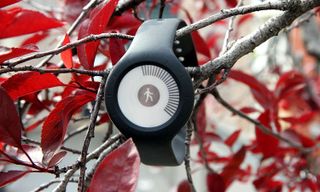
If you’re just getting up off the couch, and not sure about this whole “exercise” thing, you probably don’t want to invest a whole lot in a fitness tracker. The Withings Go ($69) is a low-risk, high-reward device that will track your steps, sleep, swimming, and calorie count, and can double as a watch with its E Ink display. Coupled with Withings’ excellent app, which also lets you track your weight and diet, the Go is a fun and compelling gadget.
Design and Display
This is as simple as it gets. Similar to the Jawbone Up Move and Misfit Flash (both of which cost around $30), the Withings Go is a small plastic disk, but the front of the Go has an E Ink display, unlike the tiny LEDs on the Up Move and Flash. It’s a basic design, but it works.
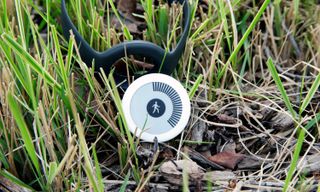
By default, the Go displays how far you are toward completing your daily step goal (small tick marks slowly fill up the screen). If you press on the middle of the display, the view changes briefly to show the time. I wish there were a way for it to constantly show the time, but you can’t have everything in a $70 device. I found it slightly annoying that I could faintly see the minute and second hands, even after the display had switched back to step tracking.
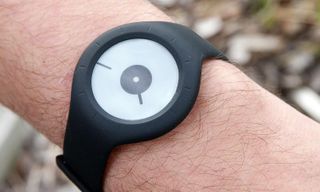
At 1.4 inches in diameter and 0.4 inches thick, the Go is a little bit larger than a quarter, and can be worn either on your wrist or on your belt. However, it will only track sleep and swimming if it’s set to the wrist mode (which you access through Withings’ app).
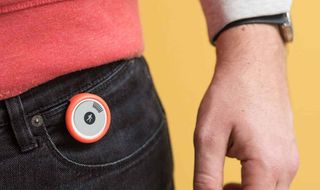
Included with the Go are a black rubber wristband and a black plastic belt clip; the wristband made the Go feel like a kid’s Swatch from the '80s. The Go will also be offered with belt clips and a green, yellow, red or blue wristband.
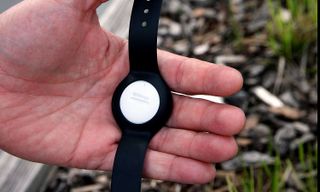
By itself, the Go weighs 0.3 ounces. With the belt clip, the weight goes up to 0.4 ounces, and with the wristband, it rises to 0.75 ounces.
I found it slightly annoying that I could faintly see the minute and second hands after the display had switched back to step tracking.
The Go is water-resistant to 50 meters (about 165 feet), which is the same as the Misfit Flash and Misfit Shine, but beats out the merely splash-proof Up Move.
Performance
The Go automatically tracks your walk, run, swim, sleep and calorie count. As you walk, the Go’s screen fills with little tick marks, indicating how far you have to go to reach that day’s goal.
MORE: Best Fitness Trackers
Since the Go’s screen doesn’t show your exact step count, you have to look at the app on your smartphone (Android and iOS) to see just how far you’ve gone. Still, it was reasonably accurate, and was within a few steps of the 500 paces that I had counted out.
Sleep tracking was also mostly on the mark, although close to my actual bedtime, it mistook me sitting on the couch, watching TV, as sleep. Unfortunately, it’s not easy to edit your sleep time, as you can with Garmin’s fitness trackers.
App
Withings’ app is elegantly laid out, and presents all your information in an easy-to-ready and friendly manner.
As you complete various activities, such as walking a certain number of miles, you earn badges in the app. It’s a fun way to visualize your progress.
A "Dashboard" separates your overall health into four cloverleaf quadrants that represent Activity, Weight, Sleep and Heart. As you complete the requirements for each quadrant — such as walking the required number of steps or getting enough sleep — the quadrant will fill with color.

Another page in the app shows a timeline of your activity broken down by day; you can drill into each to get more detailed information.

As you complete various activities, such as walking a certain number of miles, you earn badges in the app. For example, earning the Suez Canal badge means you’ve walked 200 kilometers — approximately the length of the canal. It’s a fun way to visualize your progress.
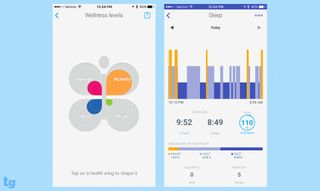
While Withings’ app doesn’t have diet tracking natively built in, you can connect it to MyFitnessPal to record your daily intake of food. You can also link the Withings app to Runkeeper, Nike+ and the Nest Learning Thermostat. The latter is only useful, however, if you have the Withings Aura ($189), an alarm clock with a color-changing LED that helps you wake up more gently. Via the Withings app, the Aura will automatically set the Nest thermostat to the preferred temperature when you go to sleep.
MORE: Do Sleep Tracking Devices Really Work?
You can also connect the app with Withings’ Smart Body analyzer, which topped our list of favorite smart scales.
Battery
The coin-cell battery in the Withings Go will last up to 8 months on a charge. To replace it, simply twist off the back of the Go and swap out the battery.
Bottom Line
The $70 Withings Go is an interesting new entry into the budget fitness tracker market. Its standout feature is its E Ink display, which is bright and bold, and Withings’ app integrates well with its other products, such as the Smart Body Analyzer.
However, there’s a lot of competition in this price range. The first-generation Misfit Shine, for instance, is now just $60, made of a sleeker aluminum, and it lets you control your phone’s camera or smart home devices. The $29 Misfit Flash does all the same things, but it's in a plastic body.
The Withings Go is a solid budget fitness tracker, but it’s worth investigating other options.
Sign up to get the BEST of Tom’s Guide direct to your inbox.
Upgrade your life with a daily dose of the biggest tech news, lifestyle hacks and our curated analysis. Be the first to know about cutting-edge gadgets and the hottest deals.

Michael A. Prospero is the U.S. Editor-in-Chief for Tom’s Guide. He oversees all evergreen content and oversees the Homes, Smart Home, and Fitness/Wearables categories for the site. In his spare time, he also tests out the latest drones, electric scooters, and smart home gadgets, such as video doorbells. Before his tenure at Tom's Guide, he was the Reviews Editor for Laptop Magazine, a reporter at Fast Company, the Times of Trenton, and, many eons back, an intern at George magazine. He received his undergraduate degree from Boston College, where he worked on the campus newspaper The Heights, and then attended the Columbia University school of Journalism. When he’s not testing out the latest running watch, electric scooter, or skiing or training for a marathon, he’s probably using the latest sous vide machine, smoker, or pizza oven, to the delight — or chagrin — of his family.
